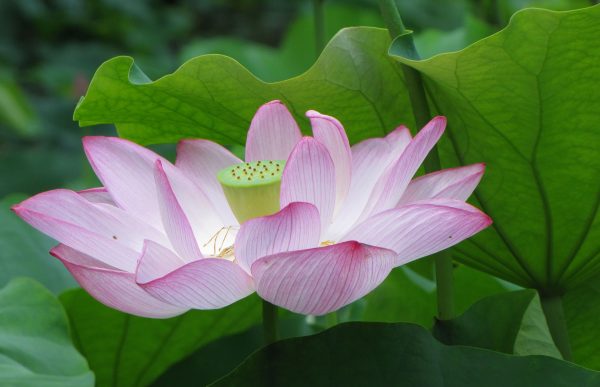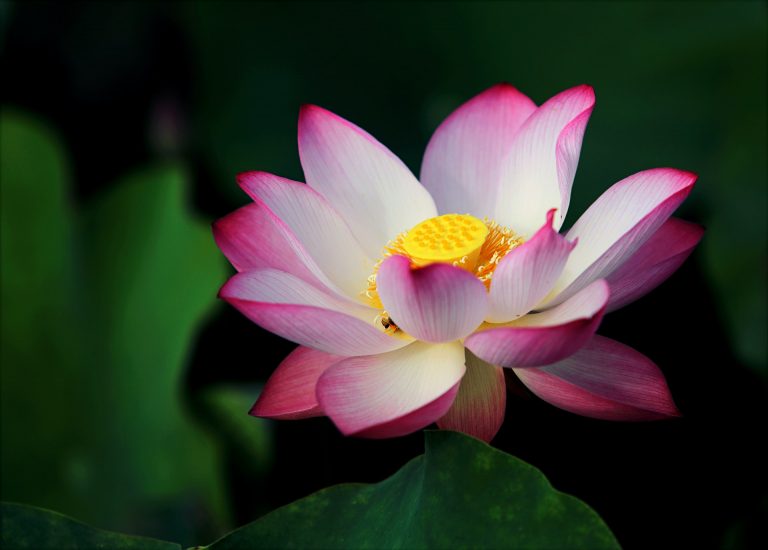Editor’s note: A special thanks to Jen Stark of Happy DIY Home for her tutorial on growing lotus flowers found here, which we learned from when writing this article.
Who doesn’t love the lotus? Exquisitely beautiful and profoundly spiritual, the lotus flower is like a gateway to another world. Remarkably, this fabulous aquatic plant is not difficult to grow… at home! You don’t even need a pond.
Before we get into the gritty details, let’s consider some of the unique properties of the lotus, and why you should consider cultivating them.
History and Tradition
As Earth’s earliest angiosperm, the lotus flower is one of the most ancient plants known. Fossil evidence shows lotus plants date back to the early Cretaceous period, or 145 million years ago. While the last ice age wiped out most plant life in the Northern hemisphere, two lotus species survived, which parented the many hybrids and cultivars available today. A key factor in their durability is the tough woody shell on the lotus seed, which must be broken or scored before the seed will germinate.
The lotus flower has spiritual significance in many Eastern traditional cultures. In China, India, and Egypt, it is considered sacred. Unlike any other plant, the flower emerges from the water to bloom in the morning, submerges, closes at night, and blooms fresh the next day. This cycle, which typically repeats three times, can be said to signify rebirth. The petals’ waxy coating allows the flower to emerge pure and clean out of the murkiest of muddy water, which thus gives rise to the symbolism of purity attached to the flower.
Success
You are now signed up for our newsletter
Success
Check your email to complete sign up
Reminiscent of the sun, the lotus is a potent icon of ancient Egyptian myths and legends and is frequently seen in hieroglyphics. It is worth noting, however, that Egyptian mythology included a blue “lotus,” which is not a true lotus (genus Nelumbo), but actually a water lily (genus Nymphaea).

Every part of the lotus plant is edible. The seeds can be enjoyed roasted or raw as a snack. The starchy root can be sliced into wagon wheels and boiled, fried, sauteed, or braised, all the while maintaining a crunchy, smooth texture. The stems, either parboiled or thinly sliced raw,
are delicious in salads. The leaves are used as edible wraps or in the dim sum classic lo mai gai, where sticky rice and other ingredients are wrapped and cooked in a package of lotus leaf.
While greek mythology paints the flower as a delicious and powerful narcotic, causing Odysseus’s men to forget their cares in blissful apathy, that was merely a mythical flower, grown on a mythical tree. The genuine lotus flower can be safely stir fried or used as a garnish.
Lotus root is a choice vegetable for adding nutrition to your diet. The tubers provide vitamin B to enhance mood, potassium to regulate blood pressure, fiber to promote healthy digestion, vitamin C to boost immunity, and vitamin A for healthy skin, hair and eyes. Diabetics must beware, however, that lotus root can reduce blood sugar levels, so careful monitoring is recommended.
The lotus plant is a medicinal treasure chest. In addition to natural health benefits from consuming lotus, Traditional Chinese Medicine (TCM) prescribes the plant in all its forms for a wide range of ailments.
Rich in iron and other minerals, many parts of the plant are nourishing to the blood. The flowers, high in calcium and iron, can alleviate inflammation and improve blood clotting.The seeds, loaded with protein and vitamins, are linked to kidney, spleen, and intestinal health. The leaves are known to cure stomach ailments and have excellent cooling properties. All parts of the plant can be taken for symptoms of mushroom poisoning.
If these are not enough reasons to grow this incredible plant, here is the clincher… the flowers actually generate heat. Thermo regulation abilities allow them to increase their temperature up to 30 degrees higher than the ambient temperature, a quality believed to attract pollinators in cooler weather.
Now you are surely dying to know where to get them and how to grow them.
Lotus cultivation and care
Lotus seeds can be purchased at a reasonable price online. Be sure to look for genus Nelumbo because you want the genuine thing. As mentioned previously, the seed shell must be compromised in some way in order to allow water to penetrate for germination. Some folks tap the seed lightly with a hammer, others use a file or a small drill. Whatever method you choose, you must be careful not to damage the tender seed inside the hard shell.
Once the seeds are prepared, place four or five seeds per one tall drinking glass filled with filtered or bottled water. Be sure to change the water every day. In about a week you should have shoots and maybe a leaf or two. Now they can be moved to a soil/mud medium.

Add 1-½ inches of soil (relatively heavy in clay) to the bottom of each small planting container. Saturate the soil with water. Plant the seeds one inch deep in individual pots. A thin layer of pea gravel will keep the soil in place when (next step) they are all submerged in water inside a larger container.
This water receptacle should be wide and shallow, with no drainage holes. A lotus will adapt to the size of its container, so if you want big lotus plants, give them ample space. Once you have aerial leaf growth (the leaves are above the surface of the water), your plants can be transferred to an in-ground location. This is often discouraged, however, as the lotus can easily become invasive, so leaving them right where they are is also fine.
If all goes well, your lotus will outgrow the small pots, so be prepared to do one more transplant.
This time you’ll want about six inches of mucky soil in the bottom of your large shallow container. Replace the plants gently in the mud and add enough water so the small leaves can float on the surface. Seed grown plants will not flower in the first year, but the leaves are delightful in themselves. If you are impatient, however, and don’t mind cheating, you can buy a living plant or start with a tuber. Use the same planting scheme, except you can start on a larger scale.
Keep your lotus plants in a warm sunny location. This is essential for blooms. When flowering and fruiting, you can give them a boost with a natural liquid fertilizer. This can be made at home in a number of ways, based on what you have on hand. Be sure to dilute the fertilizer before adding to the water.

The most common pests attracted to lotus plants come in the form of insects. The leaves are very sensitive and many sprays may harm the plant. Diatomaceous earth is helpful against aphids and spider mites, and general good hygiene cannot be overlooked. Prune away any dead material, but only above the surface, as the root relies on its connections above water for oxygen. Don’t go after your pollinators, though, which are mostly flower beetles. They will often spend the night locked inside the warm flower and leave in the morning when their job is done.
In climates where lotus roots are likely to freeze in the winter, you will need to do something to protect them. The roots of in-ground specimens should be below frost level to prevent freeze damage. Containers can be moved to a garage or shed that will provide enough shelter so as to prevent freezing. The temperature range should be above freezing but below 50 degrees. Darkness and cool temperatures will prevent the tubers from re-sprouting too soon.
If no such space is available, take the roots out, clean off any other growth, and store them a cool, dark, dry place, as you would potatoes or onions. Plant them again in a container of mud and water when all chance of frost is over in the spring.
Whether you grow them for their beauty, usefulness, or spiritual aspects, lotus plants are sure to delight your senses and bring a new personality to your garden. Like any new experience, it may involve disappointments and challenges, but take heart, and learn from the lotus. Press through the mud, pursue the light, and you will surely shine.













